Table of Contents
What To Know About Growing Mediterranean Plants
A little bit of knowledge will go a long way in adapting typically Mediterranean plants and trees to your garden landscaping. So whether you are thinking about making your entire garden into a Mediterranean oasis or just want to add a touch of exotic to your landscaping, there is an option for everyone.
What Makes Plants Grow Well In the Mediterranean
Plants and trees flourish in the Mediterranean because they have evolved to adapt to arid soil conditions and dry climates. This means they have become accustomed to saving water within their leaves and protecting themselves against nutrient loss.
Plants that are typical of this climate are hardy against drought, shrubby in nature, and can have shiny, waxy leaves and large fleshy bulbous root systems.
Other typical characteristics are spiny leaves, thick barks, and can be deciduous.
What Are Classic Mediterranean Plants
Classic Mediterranean plants include olive trees, citrus plants, agave, herby shrubs like lavender and rosemary, and flowers like jasmine and lantana.
Tips On Growing Dry Gardens
Generally fruiting trees will need a steady amount of water in the fruiting season. However, because plants of the Mediterranean climate are accustomed to mild weather, they produce a colorful palette that won’t break your water bill.
Growing a “dry garden” with plants typical of the Mediterranean requires a few garden hose splashes of water in the growing season to encourage fruit production. Here are some other tips to help start your Mediterranean landscaping.
- Pick a spot on your property that gets maximum sunlight. They love a full hot sunny day.
- Plant in well draining soil. Consider adding pumice or gravel to help with drainage.
- To begin, water deeply during the summer. During establishment Mediterranean plants need a deep but infrequent watering throughout the first two summers.
- After establishment, water 2-3 times over the growing period. Mediterranean plants tend to fail in wetter climates because of this.
- Refrain from heavy watering before winter sets in. Many woody plants need time to harden and cutting off watering before this period will help.
- Fertilize minimally. Over-fertilizing can cause excessive or weak growth. Instead prune frequently to encourage robust growth.
What Are The Best Mediterranean Plants To Grow
We have chosen Mediterranean plants that will thrive in a variety of environments outside their native land from flowers to aromatics, herbs and trees, there is something for everybody.
1. French Lavender (Lavandula stoechas)
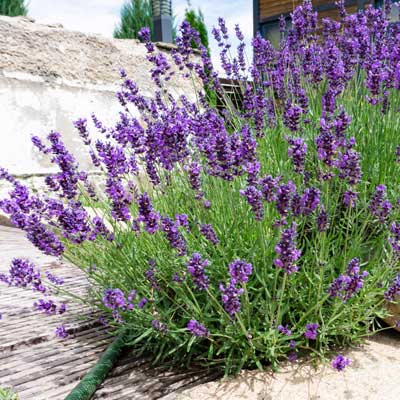
French Lavender (Lavandula stoechas)
Plant Family: Lamiaceae Mint
Mature Size Of Plant: Medium Shrub
Description: French lavender is known for its vibrant purple flowers that produce a lovely aromatic scent and long flowering season. They are a small shrub in appearance.
Tips To Grow Outside of The Mediterranean: This plant should be kept under glass in the Winter and cannot survive below -5°C. French lavender in hot climates that have mild dry Winters.They are hardy in USDA Zones 7-11.
The best time to plant is early Spring which gives time for both root development and adaptation to soil. French lavender should be planted two to three feet apart to avoid overcrowding.
If there has not been rainfall, French lavender only needs to be watered once every two weeks. Well draining soil is crucial because they prefer dry sediment for root establishment and may experience root rot if overwatered or soil has bad drainage.
2. Strawberry Tree (Arbutus unido)
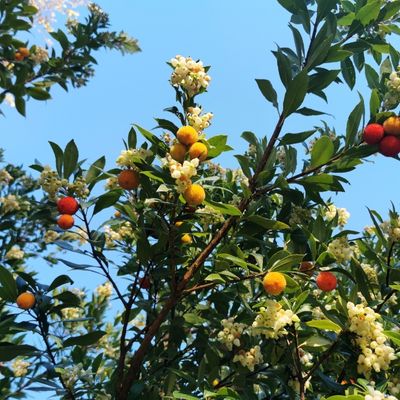
Strawberry Tree (Arbutus unido)
Plant Family: Ericaceae Heather
Mature Size Of Plant: Small-Large Shrub/Tree
**Description:**This rounded evergreen shrub or tree can reach 8-15 feet in height and equal size in width. The Strawberry Tree has leathery shiny leaves that are oval with a serrated edge
The tree produces abundant benches of white and pink flowers, and produces a fruit that ranges from ½ to 1”. The berries are edible, but have a bland taste that birds seem to prefer more than humans.
Tips To Grow Outside of The Mediterranean: This evergreen specimen grows best in full or partial sun.
The Strawberry Tree prefers well-drained substrate of clay, loam, or sand and thrives best in USDA Zones 8b-11. Roots are happy in either acidic or alkaline soil types as long as the soil is well irrigated.
3. Olive Tree (Olea europaea)
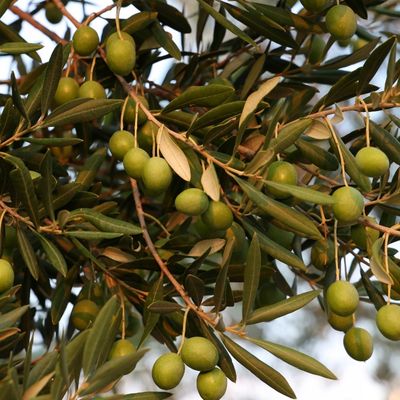
Olive Tree (Olea europaea)
Plant Family: Oleaceae
Mature Size Of Plant: Small to Large Shrub/Tree
Description: An astounding 90% of all Olive Trees are grown in Mediterranean countries like Spain, Greece, and Italy. but that should not stop you from trying to make your backyard home to an endless source of olive oil.
Olive Trees have silvery green oblong leaves and a typically gnarled and twisted trunk. They produce small white feathery flowers and produce a green or purple olive fruit from teh previous year’s growth.
Plan ahead, some varieties of olive trees can reach 20 feet in height and 15 feet in width. Steady pruning will help training for their mature tree shape.
Tips To Grow Outside of The Mediterranean: The Olive Tree can be grown in a backyard orchard setting or even a container. They tend to do best when summers are long, hot, and dry with winters that are cool and not as dry. Trees can be brought indoors to weather colder winter months in a pot if necessary.
They prefer a slightly drained calcareous or limey soil and can tolerate coastal settings. Olive trees prefer USDA Zones 9-11.
Olive trees are particular in bearing fruit. Many varieties need cross-pollination to bear olives which requires the growth of two or more varieties.
4. Judas Tree (Cercis siliquastrum)
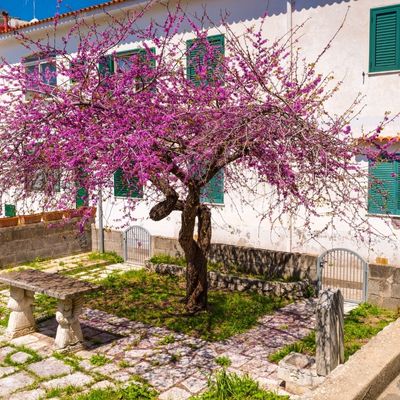
Judas Tree (Cercis siliquastrum)
Plant Family: Fabaceae Legume
Mature Size Of Plant: Small Tree
Description: Judas Trees are discernible by their compact shrubby nature with blueish round or heart shaped leaves. They bear magenta, purple, or white flowers in clusters. In addition they bear a brown legume fruit that dangles at around 4” long.
Tips To Grow Outside of The Mediterranean: The Judas Tree needs full sun, especially during the growing season, but enjoy semi sun on the hottest days. They can survive some ground frost.
The roots of the Judas Tree need constant moisture and should never be allowed to completely dry out, however, in the winter they should be kept just slightly moist. Watering should be done with a slightly acidic pH.
The Judas Tree benefits from regular fertilizing during the growing season especially where they thrive with organic fertilizer every four weeks.
This slow growing tree will benefit from pruning of older branches every Spring after flowering . In addition, the Judas tree should be repotted every 2-3 years on pace with its growth.
5. Greater Honeywort (Cerinthe major)
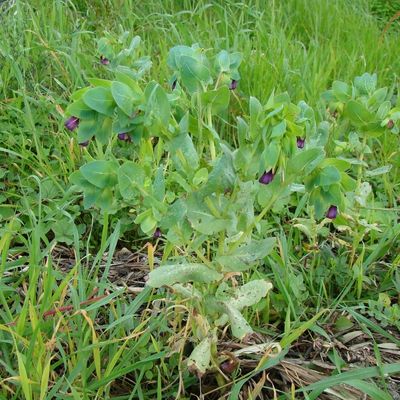
Greater Honeywort (Cerinthe major)
Plant Family: Boraginaceae
Mature Size Of Plant: 2 foot Annual
Description: The Greater Honeywort is most identifiable by its bracts - a modified leaf with a deep blue and purple flower at its axil. These vibrant flowers show their colors for weeks and are showier than the actual flower which is a small bell shaped blossom within the bract. The flowers are nectar rich making it a great gathering spot for pollinators.
This flowering annual is known to have somewhat “hairy” foliage with fibers protruding from the stems. The leaves are greenish gravy with a thick waxy exterior. When they are young, they have cream colored spots that will fade with maturity.
Tips To Grow Outside of The Mediterranean: The Greater Honeywort thrives in full sun and will give the brightest blooms in these conditions. It can however, survive with partial shade. It prefers USDA Zones 7-10.
The Honeywort is happy in various soil conditions, making it an easy grower. Soil rich in organic matter that retains moisture but drains easily is its sweet spot. Once established the Honeywort can take periods of drought and is hardy in weather changes.
6. Oleander (Nerium oleander)
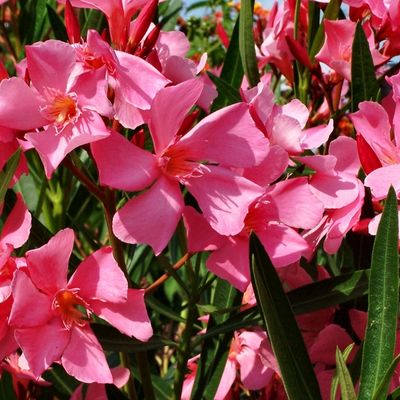
Oleander (Nerium oleander)
Plant Family: Apocynaceae
Mature Size Of Plant: Medium Shrub
Description: Oleander is a care-free flowering shrub beloved for its star-shaped flower that grows in a variety of shades, including: white, yellow, peach, salmon, and pink to burgundy red. Blossoms are known to be sweetly fragrant and durable. This shrubby blossom features long, narrow, and smooth leaves and spreads horizontally.
Oleander is often used in landscaping as an informal hedge or ornamental plant that is known for its long blooming period, but beware that it can be toxic to humans and pets.
Tips To Grow Outside of The Mediterranean: The Oleander plant is a dense, fast-growing evergreen shrub that does well in warmer climates. Tolerance to salty ocean spray and drought makes it popular in the Southern coastal states and is most hardy in USDA Zones 8-11. Once established, it is tolerant to heat and drought and needs very little maintenance.
The Oleander thrives in full sun and is tolerant to various soil types but prefers alkaline environments. If the soil is overly acidic, mixing in limestone, oyster shells, or wood ash will help to balance the pH.
7. Jerusalem Sage (Phlomis fruticosa)
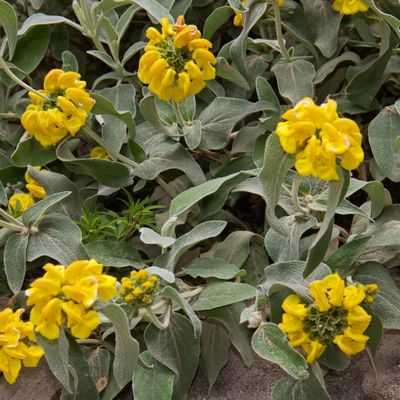
Jerusalem Sage (Phlomis fruticosa)
Plant Family: Lamiaceae
Mature Size Of Plant: 3-foot Perennial
Description: Jerusalem Sage (also known as Lampwick Sage or Turkish Sage) is a summer flowering shrub with yellow, pink, or mauve flowers that yield no scent. It is a semi-woody evergreen shrub with slender fuzzy grayish green leaves that are lanceolate shaped.
Their flowers attract pollinators like bees and butterflies and bloom in early to late spring.
Jerusalem sage has been used for its medicinal benefits, and in European culture, boiling the leaves is thought to relieve toothaches, ease digestion, and calm the throat.
Tips To Grow Outside of The Mediterranean: Jerusalem Sage is a perennial that thrives in full sunlight to partial shade and does well in the coastal US, especially in USDA Zones 4-10. They are drought resistant and need little water as long as the soil is well draining.
8. Mastic Tree (Pistacia lentiscus)
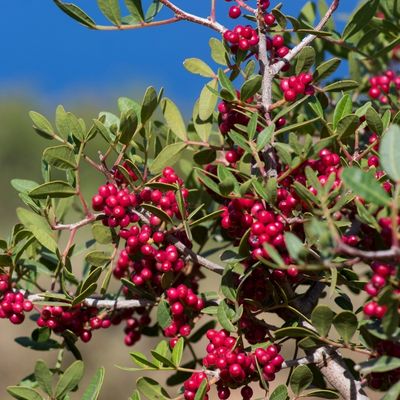
Mastic Tree (Pistacia lentiscus)
Plant Family: Anacardiaceae
Mature Size Of Plant: Medium Shrub/Tree
Description: The Mastic Tree is typically found in the hills of the Mediterranean. Modern times have made it an ornamental plant with an added function; making a particular type of Greek ice cream.
The Mastic’s leaves are divided into feathery leather leaflets that have the pungent smell of sap from the tree.
The Mastic Tree is a broadleaf evergreen that can grow between 15-25 feet high and 20 to 30 feet wide. They feature bright red flowers that bloom in the Spring and create a sap called “gum mastic”. It produces a berry that is bright red which turns black once ripe and is preferable to wildlife over humans.
Tips To Grow Outside of The Mediterranean: In nature this tree is found on the dry arid hillsides of the Mediterranean and is exceptionally drought resistant. This shrub like tree is a great option for Western states as it requires no water at all once established but can tolerate over watering as well. It thrives in USDA Zones 9-11 and prefers dry sandy well draining soils.
Elements That Make A Mediterranean Landscape
To compliment your Mediterranean plants and trees there are a few additions that will make it feel even more like the Mediterranean.
Consider planting a few varieties of Mediterranean native plants that are fragrant to create a sweet garden aroma. Lavender, Rosemary, and Italian Cypress trees will all create an exotic ambiance.
Set up a pergola to create a romantic entrance into your garden. You can wave together branches or build your own out of wood. Nectar bearing additions will attract butterflies and birds to complete the picture.
Lay down a pathway of terracotta tiles for an Italian Tuscan feel. The accessorize with rustic pots, furniture, and outdoor rugs.
Landscape upwards. Create a hilly facade reminiscent of Italy, Spain, or Greece with a terraced slope complete with blooming shrubs and ornamental grasses.
Finally, creating a garden wall can give your garden an oasis type of feel. If you already have walls, painting them a warm yellow, brown, or red will give a Mediterranean effect. Consider adding scented climbers to dangle over the walls for a beautiful effect.
What Kinds of Mediterranean Plants To Grow In Cool Climates
Many people think that you have to have Mediterranean weather to grow the same plants and trees that can be found there. With a little skill, you too can have a Mediterranean landscape even in climates like the wet and cold Pacific Northwest, as long as you prepare well-draining soil areas.
Many Mediterranean plants are woody shrubs and some that don’t require intense summer heat can do well in cooler climates.
Mediterranean plants that do well in cooler climates include:
- Yarrows (Achillea)
- Italian Cypress
- Creeping Thyme
- Crocus
- Sun Roses
- Jerusalem Sage
- Rosemary
- Lavender
Which Mediterranean Plants Make the Best Pollinators
If you are looking to attract pollinators to your gardens like bees, butterflies, and birds, there are a few Mediterranean plants that will attract this crowd. Of course, most fruit trees will attract pollinators, but apple, plum, cherry, and peach do an exceptionally good job.
Traditional Mediterranean flowering shrubs such as Woolly Yarrow, Hollyhock, Italian Bugloss, Snapdragon, and Purple Rock-cress are all diligent at making a home for pollinators as well.
Recent Articles

















